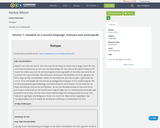
Texttyper Svenska som andsraspråk
- Subject:
- Languages
- Material Type:
- Activity/Lab
- Author:
- Andon Minev
- Date Added:
- 01/19/2020

Texttyper Svenska som andsraspråk
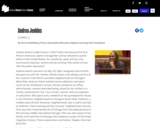
Andrea Jenkins made history in 2017 when she became the first African American, openly transgender woman elected to public office in the United States.
This resource is from a collection of biographies of famous women. It is provided by the National Women's History Museum, and may include links to supplemental materials including lesson plans about the subject and related topics, links to related biographies, and "works cited" pages. The biographies are sponsored by Susan D. Whiting.
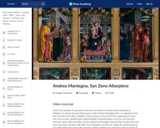
Andrea Mantegna, San Zeno Altarpiece, 1456-59, oil on panel, 212 x 460 cm / 83 x 180 inches, comissioned by the Benedictine Abbot, Gregorio Correr (Basilica of San Zeno, Verona). Created by Beth Harris and Steven Zucker.
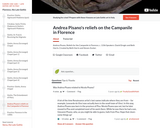
Andrea Pisano, Reliefs for the Campanile in Florence, c. 1336 Speakers: David Drogin and Beth Harris. Created by Beth Harris and Steven Zucker.

Carnegie, Andrew. "The Gospel of Wealth" Carnegie Corporation of New York. 2017,p.11-14, https://media.carnegie.org/filer_public/0a/e1/0ae166c5-fca3-4adf-82a7-74c0534cd8de/gospel_of_wealth_2017.pdfDescription: A millionaire industrialist addresses his philosophy of philanthropy
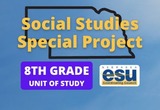
This inquiry focuses on the defining themes of Andrew Jackson’s presidency. Students will discuss Jacksonian Democracy, the War on the National Bank, and policy toward Native Americans. The questions, tasks, and sources in this inquiry ask students to explore primary sources from multiple perspectives to analyze whether Jackson was the hero or villain of the common man. Resource created by Abigail Huggins with Doniphan-Trumbull Public School as part of the Nebraska Social Studies Special Project 2022 - Inquiry Design Model (IDM).

This resource is a video abstract of a research paper created by Research Square on behalf of its authors. It provides a synopsis that's easy to understand, and can be used to introduce the topics it covers to students, researchers, and the general public. The video's transcript is also provided in full, with a portion provided below for preview:
"Polycystic ovary syndrome (PCOS) is a common endocrine disorder in women and is characterized by irregular periods, infertility, and hirsutism. Patients with PCOS also regularly experience gut dysbiosis, but the specific role of dysbiosis in the pathology of PCOS is not clear. To investigate this, researchers administered two different treatments to rats – the androgen dehydroepiandrosterone (DHEA) to induce PCOS-like symptoms and antibiotics to deplete the existing microbiota and thereby produce “pseudo germ-free” rats. In the androgen-treated rats, depletion of the microbiota did not protect them from PCOS-like symptoms, but transplanting microbiota from androgen-treated rats into pseudo germ-free rats triggered disruption of reproductive hormone balance and altered liver metabolism..."
The rest of the transcript, along with a link to the research itself, is available on the resource itself.

Androgoji ve pedagoji arasındaki temel farkların yer aldığı bulmaca yetişkin eğitimi modülü içerisinde eğitimciler tarafından etkinlik ya da ödev olarak kullanılabilir.
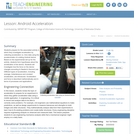
Students prepare for the associated activity in which they investigate acceleration by collecting acceleration vs. time data using the accelerometer of a sliding Android device. Based on the experimental set-up for the activity, students form hypotheses about the acceleration of the device. Students will investigate how the force on the device changes according to Newton's Second Law. Different types of acceleration, including average, instantaneous and constant acceleration, are introduced. Acceleration and force is described mathematically and in terms of processes and applications.
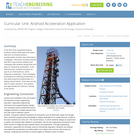
In the first of two sequential lessons, students create mobile apps that collect data from an Android device's accelerometer and then store that data to a database. This lesson provides practice with MIT's App Inventor software and culminates with students writing their own apps for measuring acceleration. In the second lesson, students are given an app for an Android device, which measures acceleration. They investigate acceleration by collecting acceleration vs. time data using the accelerometer of a sliding Android device. Then they use the data to create velocity vs. time graphs and approximate the maximum velocity of the device.
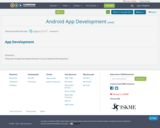
Using the Google developed lessons to learn Android Development.
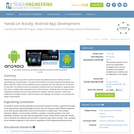
Students develop an app for an Android device that utilizes its built-in internal sensors, specifically the accelerometer. The goal of this activity is to teach programming design and skills using MIT's App Inventor software (free to download from the Internet) as the vehicle for learning. The activity should be exciting for students who are interested in applying what they learn to writing other applications for Android devices. Students learn the steps of the engineering design process as they identify the problem, develop solutions, select and implement a possible solution, test the solution and redesign, as needed, to accomplish the design requirements.

This resource is a Hands-On course to teach Apps Development to students who may not have any programming knowledge. This course has no pre-requisites. It’s time to add the 4th R – Reading, wRiting, aRithmetic and algoRithmic thinking. In a world where the majority of new jobs require science, technology and math skills, it is time our Liberal Arts majors get IT (Information Technology)! While employers recognize and value the importance of liberal education and the liberal arts, they also want liberal arts graduates who are not digitally challenged. Many employers report a “skills gap” as they have trouble finding recent graduates qualified with ample digital skills to fill various positions. Meanwhile, a national educational movement in computer coding instruction is growing at lightning speeds in schools across the US and many consider coding more like a basic life skill (which might someday lead to a great job) rather than an extracurricular activity. App Inventor (AI) serves to narrow this skills gap and increase the versatility of students to become active creators of technology and “digitally” ready for the workplace rather than just being passive consumers of technology. Sales of hand-held devices (smartphones, tablets and phablets) are exploding. These on-line, social, and increasingly mobile computing devices are ubiquitous and offer visual, tactile and personal experiences as never before. Mobile devices in our education landscape are digital and portable - with multimedia capabilities to access the Internet, and are drastically changing the ways we teach and learn. Developing applications for such devices enables digital natives to experience mobile technology as active creators rather than just passive consumers of technology.
Learning Goals
Learn Apps Development
Learn Digital Skills (essential for a Liberal Arts major)
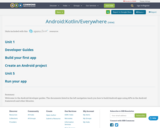
Welcome to the Android developer guides. The documents listed in the left navigation teach you how to build Android apps using APIs in the Android framework and other libraries.
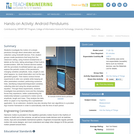
Students investigate the motion of a simple pendulum through direct observation and data collection using Android® devices. First, student groups create pendulums that hang from the classroom ceiling, using Android smartphones or tablets as the bobs, taking advantage of their built-in accelerometers. With the Android devices loaded with the (provided) AccelDataCapture app, groups explore the periodic motion of the pendulums, changing variables (amplitude, mass, length) to see what happens, by visual observation and via the app-generated graphs. Then teams conduct formal experiments to alter one variable while keeping all other parameters constant, performing numerous trials, identifying independent/dependent variables, collecting data and using the simple pendulum equation. Through these experiments, students investigate how pendulums move and the changing forces they experience, better understanding the relationship between a pendulum's motion and its amplitude, length and mass. They analyze the data, either on paper or by importing into a spreadsheet application. As an extension, students may also develop their own algorithms in a provided App Inventor framework in order to automatically note the time of each period.
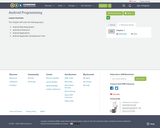
This Chapter will cover the following topics Android Operating System Android Architecture Android Applications Android Application Development Tools
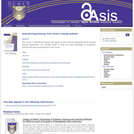
This course is intended for people who aspire to learn android programming and develop android applications. The learners needs to have the basic knowledge of computers, Internet and java programming for this course.
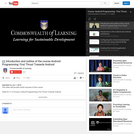
These video lectures are intended for people who aspire to learn android programming and develop android applications. The learners needs to have the basic knowledge of computers, Internet and java programming for this course.
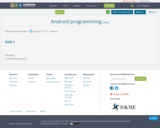
Android programming
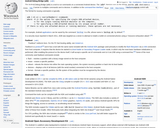
Android software development is the process by which new applications are created for devices running the Android operating system.